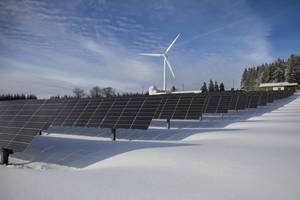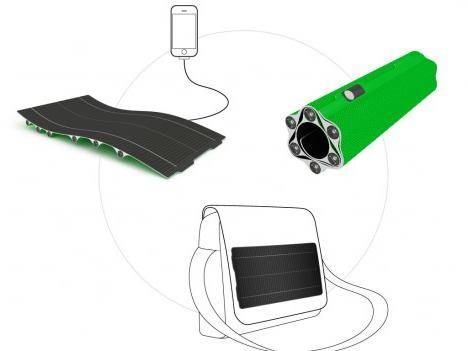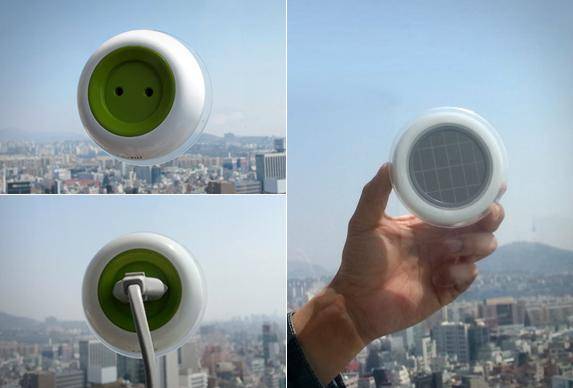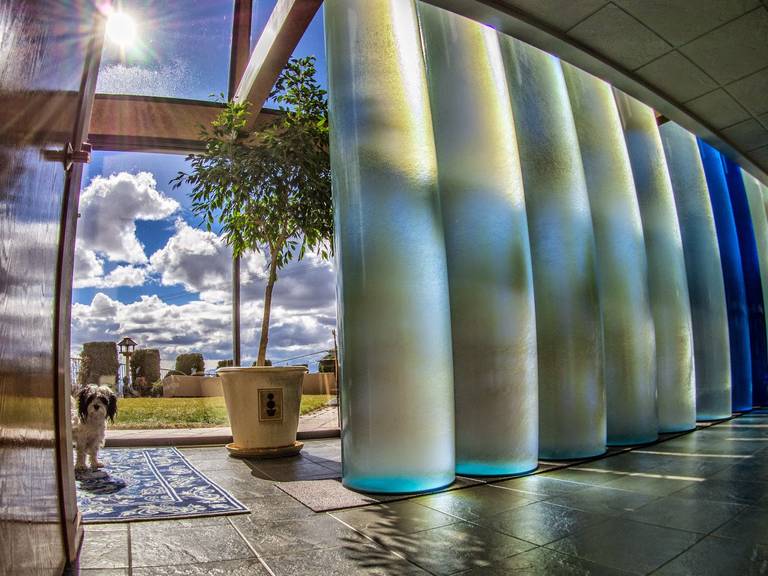Portable Solar Space Heaters: The Ultimate Guide
When someone mentions space heaters, what usually comes to mind is some device drawing kilowatts of electric power.
But it doesn't have to be like that.
For the last 10 years, I have successfully used a solar powered heater and the free sun's energy for space heating.
I'll explain how in a minute.
First, let's see how and where you can use solar space heaters, so-called "solar thermal air heaters".
Table of Contents
Solar Air Heater Applications
By simply heating the air, you can accomplish the following:
- SPACE HEATING: Direct Hot Air Heating, Heat Pump Preheat, Air Radiant Floor Heating
- WATER HEATING: Water Preheat
- EQUIPMENT HEATING: Clothes Dryer Air Preheat, Heat Pump Heating
Solar Space Heating
You can use solar air heaters in a variety of ways to provide space heating for your home.
For example, you can use solar powered space heater to heat air blown directly into the house's living spaces. This is called direct solar air heating.
The solar air heater will send heat into the house whenever the solar-heated air is warmer than the house.
You can also use solar air heaters to heat your house indirectly. For example, suppose you have an unheated basement or crawl space beneath your house. In that case, you can blow solar-heated air directly into the crawlspace or basement. The warm solar-heated air will rise up to the heat the underside of the first floor. This is the simplest form of radiant floor heating and is one of the most comfortable and productive solar heat methods.
Another indirect use of solar heat is to use solar air heaters to provide solar-heated air to the outside unit of a heat pump. Using this approach causes the heat pump to work more efficiently and produce more heat with less electricity.
If you have a boiler heating your house, you can use solar air heaters to preheat the air that the boiler pulls from the house to burn with fuel to heat water.
Suppose you operate bathroom fans, clothes dryers, kitchen exhaust fans, fireplaces, gas, propane, or oil water heaters. In that case, you can use your solar air heaters to preheat outside air that enters the house to feed these fans and fuel-burning appliances.
Direct Space Heating
The solar air heater can blow warm solar-heated air directly into the living spaces to individual rooms or heat larger spaces. The solar air heaters are set up to pull fresh outside air in at one end and discharge warm solar-heated air at the other end.
The solar air heater is designed to deliver air about 40 degrees F warmer than the outside air. For example, on a 45 degree sunny day, the solar air heater will deliver air at 85 degrees. solar air heaters will deliver warm air suitable for Direct space heating during much of the heating season for many climates.
However, there will be days when the outdoor temperatures are colder than 35 degrees, there is a strong cold wind, or the skies are partly cloudy when the solar air heater outlet temperature is below 75 degrees. In these conditions, most people will find that the solar-heated air is not adequate for direct space heating and will rely solely on their conventional heating system. Fortunately, solar heated air from the solar air heaters is still useful for many Indirect Space heating applications, producing significant savings on heating bills.
Indirect Space Heating
The indirect space heating applications include:
- Air radiant floor heating
- heat pump preheating
- Outdoor air preheating
- boiler air preheating
- garage heating
- workshop heating
How To Use a Solar Air Heater
How to Use Solar Air Heater for Direct Space Heating
Direct Space Heating is useful where the solar air heater air temperature is more than 10 degrees F warmer than the indoor room temperature. For example 85 F solar air to a 75F room. In this case, the solar-heated air can be blown directly into the occupied space. Even at this temperature, the air stream moving at high speed directly from the fan will feel cool. (Try blowing your 85F breath across your hand 6" from your face, it will feel cool due to the moving air). However, a room full of 85 F still air will feel warm.
Most solar air heater installations are designed to deliver outside fresh air, on sunny days, at about 35-50 degrees F above outdoor temperatures. So, the solar air heaters can be used for direct space heating whenever the outside air is above about 40 degrees F (above 75-90F delivered solar air temperature). The solar air heater air temperatures will obviously drop off if it is cloudy or early morning or late afternoon.
There are three ways to control the operation of the solar air heater fan to ensure that the fan runs when solar heat is available and stops when solar heat is not available. First, you can manually turn the solar fan OFF and ON to match the solar heat available. You can also control the solar air heater with a thermostat that turns it on whenever the temperature of the solar air heater is above a certain temperature, say 75 F. You can also control the solar fan with a Differential Temperature Controller that will turn the fan ON whenever the solar air heater air temperature is warmer than the indoor temperature or any other temperature you set.
To bring the solar heated air into the house, you have two options:
- cut a hole in the house for a duct to carry the solar heated air into the house,
- use a window air supply unit to make a Solar Window Heater.
Cutting a hole in the house wall (or soffit or the bottom of a bay window) allows you to bring the solar heated air into the house. This may also allow you to install the fans and controls out of the weather. You can also connect the fans to ductwork in the house to help move the heat to wherever you can best use it.
It is strongly recommends that any solar ductwork inside the house should be metal or approved flexible duct. The outdoor corrugated polymer duct is an ideal solar duct for outdoor use. Still, it is not an approved duct for use within buildings. Flexible and rigid metal ducts are available from most home centers and hardware stores. In addition, hardware stores sell an adapter to adapt the outdoor corrugated polymer duct to indoor duct.
House with solar air heater window heater
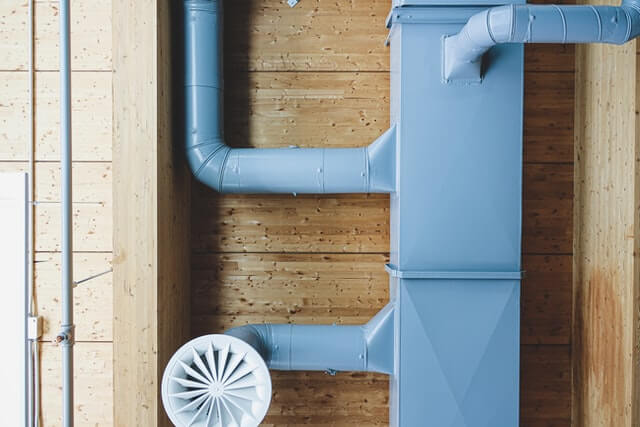
The window air supply unit is a removable unit that fits in a slightly opened window and connects to the solar air duct. It fits in most vertical opening windows and can be purchased with or without a solar fan attached. This approach delivers a very adaptable solar window heater unit. Unlike conventional window heaters that are only designed to accommodate small solar collectors that face directly out from the window, the solar air heater solar window heater can be arranged to face any angle from the window. It can even be installed around the side of the house and still deliver solar heat to the window. The window unit with a pre-wired fan means you simply have to plug the systems into the socket near the window to start heating the room. The window unit without a pre-wired fan is appropriate for installation where an outdoor fan is already installed. In the summer, simply remove the window unit, and store it until the next heating season.
How to Use Solar Air Heater for Heat Pump Preheating
Heat pumps can provide efficient heating when the outdoor temperature is above 50 degrees F. However, the heat pump doesn't work very efficiently when the temperatures drop into the 40s and 30s and below. As a result, it becomes one of the most inefficient heating systems, not much better than electric resistance heat in an electric furnace or baseboard heater.
However, suppose solar air heaters are used to preheat the air flowing across the outdoor coil of the heat pump. In that case, you can dramatically improve the performance of the heat pump. The warmer air moving across the coil means that the heat pump can operate without electric resistance heat, saving electricity and money. The most significant benefit of this approach is that you can use the solar heated air from the solar air heaters to heat the heat pump, even when it is colder than comfort temperatures. So you get more hours of use and energy savings from your solar air heaters than if you just used them when they were delivering air at 85 F and above. They will save energy at the heat pump even if they deliver 50 F air on a 10 F degree day.
To preheat outdoor air for a heat pump, you need to send the warm air stream across the outdoor coil of the heat pump. This is done by bringing the outdoor solar duct up to the heat pump and flooding the air around the heat pump with warm solar air. A section of outdoor duct that is perforated to allow solar air to be released is installed on the ground around the base of the heat pump. This section is installed about 8 inches away from the unit's base to allow unimpeded airflow across all coil areas during summer and winter.
The fan inside the outdoor unit will draw air across the heat pump coil. As it pulls air across the coil it will move both the solar heated air and any additional cold outside air it needs across the coil. The more solar-heated air you can provide, the better the heat pump performance will be.
Typical airflow across the outside coil of a heat pump is about 800 cubic feet per minute for every "ton" (12,000 BTU/hr) of heating capacity. A 3-ton unit is typical for a 2500 square foot home. So, outside airflow can be around 2400 cubic feet per minute for an average home.
There is no need to solar heat this entire volume of air. Instead, preheating up to a maximum of about ¼ of this air is a better strategy. The preheated air will blend with the outside air to boost the temperature seen by the heat pump. This elevated temperature will result in higher efficiency.
During the spring and fall when the weather is cool, in the 40s and 50s, the solar heated air will bring the blended air temperature up to about 60 F. Most heat pump manufacturers set a maximum operating temperature for their heat pumps of about 60 degrees F. That is why you must use a thermostat that shuts down the solar airflow when the blended air temperature reaches above 60 F. If you know the manufacturer's maximum operating value, you can adjust the thermostat to shut down when the blended air temperature reaches about 5 F below the maximum. A few heat pumps, e.g., many pool heating heat pumps, have higher operating temperatures. In those cases, you can set the solar airflow cut-off thermostat to higher temperatures according to the manufacturer's stated values.
The strategy that delivers the most solar heating benefit is to use the solar-heated air directly for space heating, whenever it is warmer than the indoor air, and to run an exhaust fan that exhausts the excess household air across the heat pump coil. Whenever the solar air temperature is below comfort temperatures for direct space heating, the solar air can be sent across the outdoor coil. This approach is more complicated and requires the coordination of two fans. Still, it will deliver more hours of heat at higher efficiency than just heat pump preheating alone.
How to Use Solar Air Heater for Air Radiant Floor Heating
People who have radiant floor heat know how comfortable it can be. The reasons are simple:
- the floor stays warmer,
- the floor temperature stays more stable,
- the temperature from the floor to the ceiling stays more even,
- the humidity level can stay higher,
- air movement in the room is lower than with other direct air heating systems.
Without radiant floor heating, the floor temperature drops to low 60s. It can be colder if it is over an uninsulated crawlspace. The chart below shows one example of actual crawlspace temperatures in a modular building in North Carolina during three winter days. During those days, the skies were clear and sunny. A solar air heater system would have produced solar-heated air at about 40 degrees warmer than the outside air and filled the crawlspace with warm air. The chart shows the estimated temperature at the top of the crawlspace, just under the floor. The solar air heater system floods the crawlspace with warm air.
Usually, a radiant floor heating system requires a boiler and miles of continuous plastic tubing buried in concrete poured on top of the floors or tubing wound tightly against the bottom of a plywood subfloor, wrapped in shaped aluminum plates, and stapled against the plywood. Hot water is pumped through the water tubing to heat the subfloor below the finished flooring. The maximum temperature of the finished flooring only needs to be 80 degrees F to influence comfort significantly.
However, there is a much simpler way to achieve the benefits of a radiant floor: air as the radiant heating fluid. solar air heaters have been used to heat crawlspaces below first floor rooms to deliver Air-Radiant Floor heating. No complicated plumbing is required because the warm air does all the work of transferring heat to the floor.
To use this method in a crawlspace, you need to connect the solar air duct from the solar air heaters to a crawl space vent or to an unfinished basement. The warm air from the solar air heaters will rise up to below the first floor and heat the plywood subfloor. Since heat rises, the heated air will move up into the crawlspace and hug the plywood subfloor overhead. Once the plywood floor is heated, the heat in the subfloor will rise through the plywood to heat the finished floor inside the house. No air moves through the floor. It is simply heat moving from the warmer air below, through the wood, to the colder interior finished floor. The large mass of plywood and floor joists in the subfloor (approx. 5,000 pounds per 1,000 sq.ft.) will act to retain heat and release it gradually to the finished floor above. That gradual release of heat will carry the heating effect into the evening hours.
In many cases, there is no need to run ducts through the crawlspace since the heated air will always spread out and rise to cover the subfloor. However, suppose you have a large crawl space. In that case, you may want to install several separate solar air heater systems to quickly distribute the heated air to widely separated parts of the space.
Suppose you have insulation below the subfloor, and you have convenient access to the crawlspace. In that case, you may want to open a few areas of the insulation to allow the solar heated air to move up past the insulation to contact the subfloor. If this is impractical, you can still benefit from the solar-heated air moving against the bottom of the insulation.
In such a case, the insulation and floor joists will become warmer. The heat will move slowly up through the insulation to the subfloor.
To attach the solar duct to the crawl space vent, you can use a duct outlet available from the online store. The duct vent can be connected by wiring the outlet to the crawlspace vent then attaching the solar duct to the outlet. See the photos. In this case, the fan would be installed outdoors between the solar air heaters and the crawlspace vent.
You may wish to bring the solar duct directly into the crawlspace, where you can attach the fan and power supply inside, in a dry location. If you can remove the crawlspace vent screen, you can bring the solar duct into the crawlspace. If you have wooden or sheet metal crawlspace walls, common in manufactured or mobile homes, you can cut a hole in the walls to bring the solar duct inside. In older homes with stone walls around the crawlspace, you may be able to remove enough stones to create an opening.
If you have water pipes in the crawlspace, the solar heated air can help keep them from freezing in cold weather. However, you should ensure that the power to the solar fan is controlled by a thermostat that will prevent it from operating when the solar air supply temperature drops below 40 F. This is to prevent the fan from operating at night when it can bring cold air into the crawlspace. It is best to operate the system from a differential temperature controller to turn the fan on whenever the solar air heater temperature is warmer than the crawlspace temperature.
Suppose you live in a cold climate where freezing is likely. In that case, you should consider a backup pipe heating system, such as heat tapes, for extended cold or cloudy days or nights when solar heating is not available when solar. If your heat tapes are thermostatically controlled, the additional solar heating will reduce the electrical energy use of the heat tapes.
How to Use Solar Air Heater for Clothes Dryer Preheating
Clothes dryers use nearly 5% of all the energy used in a home. Usually, they are electric dryers that use electric resistance heat to warm the air in the dryer. Unfortunately, electric resistance heat is one of the most expensive forms of heat. So, running the clothes dryer for a few hours per week can add a couple of hundred dollars to the annual household energy bills.
In addition to using heat within the dryer itself, clothes dryers also pull heated air for the house and exhaust it out of the dryer vent. Heated household air goes in the dryer air intake and out the dryer exhaust vent. A typical dryer airflow is about 150 cfm (cubic feet per minute) or 7500 cubic feet of air per hour. After only 2 hours, a clothes dryer will have pulled all the heated air in a 2000 square foot house out through the dryer vent.
If that's the case, how come there is still warm air in the house after the dryer has run for a while? In fact, how come there is any air at all? The reason is that outside air is leaking in to fill the vacuum created by the dryer blowing air out of the house. The cold outside air can leak into the house from various openings, cracks, and leaks in the walls, floors, bathroom vents fans, oven vent fans, leaky windows and doors, leaky chimney dampers, etc.
You may feel the effects as cold drafts throughout the house as the air moves in and blends with the warmer air in the house. After a short time, you will also feel the effects when you hear the furnace/boiler/heat pump turn on to heat all the cool air now filling the house. So running the clothes dryer not only uses energy in the dryer, it also uses energy to heat the cold air entering the house.
However, suppose solar solar air heaters are used to preheat a supply of air for the clothes dryer. In that case, you will save energy in two ways: dryer heating energy and house heating energy. You can deliver the warm solar-heated air to the area of the dryer air intake. This will minimize the heating by the electric (or gas) heater in the dryer, as it raises the dryer air temperature toward the dryer setting (high, medium, low, etc.). It will also eliminate household heating caused by the cold air leaking it to supply the dryer air. Eliminating the cold air leaking in around the house reduces the time the furnace/heat pump/boiler needs to run to keep the house warm. Even if the solar-heated air is only 60 degrees, on a 20 degree day, it will ease the burden on the heating system which would otherwise have to overcome 20 degree air entering the house.
To use this approach, the solar-heated air should be discharged "in the area" of the dryer air intake, which is typically in the bottom near the back or side of the dryer.
DO NOT CONNECT THE SOLAR AIR DUCT DIRECTLY TO THE DRYER INTAKE
The dryer must be able to pull air from the room at all times. Terminating solar air duct at floor level …WITHIN A FEW FEET OF THE DRYER AIR INTAKE …..is acceptable. The solar-heated air will flood the area around the dryer air intake with warm air in this location. Whenever the dryer runs, it will pull as much warm air as possible into the dryer air intake. Suppose the solar air supply is not available or slightly less than the dryer airflow. In that case, the dryer will pull as much additional room air as it needs to achieve its proper airflow.
NEVER RESTRICT THE AIRFLOW TO THE DRYER OR COVER OR BLOCK THE DRYER AIR INTAKE IN ANY WAY, AS IT CAN CAUSE OVERHEATING AND START A FIRE.
SUPPOSE YOU HAVE A GAS-FIRED OR PROPANE-FIRED CLOTHES DRYER. IN THAT CASE, YOU SHOULD HAVE A QUALIFIED PLUMBER OR APPLIANCE INSTALLER CONFIRM THAT THE ARRANGEMENT OF THE SOLAR AIR SUPPLY IS ACCEPTABLE.
IF YOU HAVE ANY QUESTIONS ABOUT THE PROPER OPERATION OF A GAS APPLIANCE IN THE SAME ROOM AS THE SOLAR AIR SUPPLY, CALL A QUALIFIED PLUMBER OR APPLIANCE INSTALLER.
During the summer months, the solar-heated air may be all that is necessary to achieve proper clothes drying temperatures. So you may be able to set your dryer to a no heat setting and simply let the solar heated air do the drying. This may take longer, but you will save more energy. However, you may wish to operate the solar fan manually during those summer months whenever you turn on the dryer.
If the fan operates automatically, you may want to install a manual damper in the solar duct. The dumper will divert the solar-heated airflow out of the house when the dryer is not operating but can redirect it to the dryer intake when the dryer is operating.
How to Use Solar Air Heater for Water Preheating
Most solar water heating systems are actually water "preheating" systems. Before entering the house from the well or city water main, they preheat water that enters the regular water heater. The solar heat is collected from panels, as either heated air, or heated water, or a heated antifreeze solution. The solar heat in the air or water/antifreeze is then passed to the household water supply by an air-to-water heat exchanger or a liquid-to-water heat exchanger. This household water is stored in a storage tank that then feeds into the regular household hot water heater. The typical hot water heater delivers water to the sinks and showers and laundry, etc. See the image below.
In most of the US, the household water comes into the house from the city water main, or the well, at between 45 and 65 degrees F.
This cold water moves into a solar preheat tank where the solar heated air or water/antifreeze fluid heats it from its cold temperature to as much as 140 F. The solar heat delivered from the panels is low in the early morning hours, but in the morning hot water use is high. This is because about ½ of the daily hot water load is in the early morning. So, solar heating panels can not instantaneously provide all the heat necessary to meet the morning hot water needs, without some storage of heat collected throughout the previous day.
To provide this storage, the solar preheat tank takes in the coldest water (~50F). It preheats it with solar heat throughout the day and stores the preheated water until the regular hot water heater needs it. When water is drawn from a faucet or shower, water moves out of the regular water heater at about 120F. It is replaced by warm/hot water from the preheat tank. The water drawn from the preheat tank is replaced by cold city/well water. For example, suppose solar heat preheats the water from 55 to 90F. In that case, the regular tank only has to heat the water from 90F to 120F, cutting the electric/gas/oil heating load by more than half.
During the sunny, warm summer, the preheat tank might easily reach 120F by the end of the day, eliminating most of the hot water heating load. However, during the coldest winter days, a collector's air (or water) might not be warmer than 70F. While that's too cold to heat the air in a house directly, it is still warm enough to preheat water coming into the house 45F. So a solar air heating hot water preheat system can make use of solar-heated air year-round. (Even when the delivered air temperature is too cold for direct space heating).
There are two ways to install such a system. The first way uses an integral tank and heat exchanger. The second way uses a copper coil outside the tank to transfer heat from the air to water in the coil and a water pump to circulate solar-heated water from the coil to the preheat tank.
The first way (integral tank and heat exchanger) uses fewer moving parts, costs less, uses parts available from any good sized home center or plumbing supply store, and requires no electrical work. A schematic is shown in the figure above.
The preheat tank to use is a conventional, tank-type, gas hot water heater. The tank acts as the preheat storage volume. The internal flue and tank bottom above the burner area act as the heat transfer surfaces for solar-heated air to heat the water in the tank. This is exactly the same duty these surfaces perform when gas is burned in a conventional gas hot water heater; only the solar-heated air is lower temperature and constantly runs through the day.
However, in this case, NO GAS IS CONNECTED TO THE TANK.
In fact, it is strongly recommended that the internal burner be removed from the tank and the gas valve be removed, or at least labeled to prevent anyone from connecting gas in the future.
You will achieve the best performance by introducing the hottest solar-heated air into the flue at the top of the tank and letting the air exit at the bottom of the tank. For example, a 40-gallon residential gas hot water heater will typically have a flue pipe that is 3 inches in diameter. A 3-inch duct can carry solar heated air from the solar air heaters to the top of the tank. The 3-inch sheet metal duct can be clamped over the flue to direct the solar heated air down the flue to the 'burner' area. You may need to make a small cut in one end of the 3-inch diameter duct to fit it over the 3" flue pipe. Use metal foil tape or duct tape around the joint, and then install a hose clamp over the tape at the top of the flue to secure the duct and flue.
The solar-heated air will pass down the flue and out the air outlet at the front of the tank. You have the choice of collecting and re-using the solar-heated air that passes through the outlet of the preheat tank, or you can simply let it exhaust into the room. The airstream will still have some useful heat that can be used for other purposes as it exits the tank. However, in the summer you will probably want this air sent out of the house. So, re-using this solar-heated air will add to your savings and keep the room more comfortable in summer.
To collect this exhausted solar air requires that an adapter be built to the front of the air outlet. Gas hot water tanks have a variety of air outlets at the bottom. For older tanks, the air would exit through the door at the front of the burner area. Modern tanks usually have the 'burner' door area tightly sealed. They have different air inlets on the sides or bottom of the tank. These air inlets have systems to prevent gas flames from burning backward out through these inlets. Since the solar preheat tank has no gas connection or open flame, these inlets are not required. These inlets include spring-loaded baffles, fine mesh screens, and other mechanisms. These systems can be disabled to direct the exiting air to the 'burner' door area with whichever system you have on your preheat tank. At the 'burner' door area, you can capture the exiting air in a duct to direct it to any other useful purpose, such as clothes dryer air preheating, combustion air preheating, ventilation air preheating, or crawlspace preheating. Then, during the summer months, you can direct this warm air out of the house.
As shown in the photos, you can install a small section of 3" or 4" rigid metal duct at the burner door. The small duct should be feathered on one end with small cuts around the length to make tabs that can be bent back for attachment. The other end should be crimped to allow attachment of another duct to direct the exhaust flow. The feathered end is placed up to the 'burner' opening and between the duct and opening should be taped tight to the perimeter of the 'burner' door. Taping the inside of the joint, where the duct is attached to the opening, can be accomplished by reaching inside the duct with several small pieces of tape.
The figure below shows data taken from several days of operation of an air to water preheats tank with integral air to water heat exchanger. The temperatures shown are air temperatures at the top and bottom of the tank and outside air temperature. The air temperature difference between the top and the bottom represents heat given up by the air to the colder water in the tank. At the end of the spring day, the system delivered over 10000 BTU of heat to the water used in the household throughout the day. Higher energy delivery would be expected during the hotter summer months, with higher solar air temperatures.
The air exiting the bottom of the tank was as hot as 90 degrees during the peak hours of these April days. That exhaust air was ducted to the nearby clothes dryer air intake and used for dryer air preheating, direct space heating, and boiler air preheating.
The second approach to water preheating is to use an air to water heating coil and a separate tank and pump. The solar-heated air heats water in the coil, continuously circulating through the coil and to the tank. Colder water from the bottom of the tank circulates back to the coil. The coil can be sized to maximize the heat transfer surface between the water and air. This transfers more heat to the water than the integral tank and heat exchanger, with its fixed heat transfer surface. However, the coil approach adds more parts, more expense, more complexity, and another electrical and piping connection compared to the integral tank and heat exchanger.
Solar Space Heater FAQs
Can solar air heaters heat my house?
Solar air heaters can heat a house. However, your best use of solar-heated air is to reduce the heating and cost of your conventional heating system. You will want to have a traditional heating system for backup cloudy, rainy, or snowy days or nights. On many sunny days, your backup system may not need to run at all. On colder days, your backup system will not need to run as much since solar heat will be providing a portion of your daily heating needs.
What's the difference between solar air heating and solar water heating?
Solar air heating uses no water or liquid in the solar collector system. Since there is no water in the collector, there is no risk of water leaks or damaging the collector by freezing or boiling the operating fluid. Solar air heating delivers warm solar-heated air that can be used directly for space heating or indirectly for hot water preheating, fresh air preheating, Air Radiant Floor heating, and other uses.
How many solar air heaters do I need?
The number of solar heat you need depends on a variety of factors. These include your current heating needs, how you will use the solar heat (year-round or heating season only), what you want to heat, (living space, crawlspace, hot water preheat, etc.). Therefore, the precise estimate can be complicated. However, you can add as many as you want using simple ducts and connectors to increase the solar heat you receive with the modular solar air heater.
How much will I save?
The amount you save depends on your current cost of heat, the amount of heat you use during a year and the amount of sun that falls on your solar air heaters. For example, use the solar air heaters year-round to heat your home in winter and water all year long. You can save about 5 million BTU per year for each solar air heater. Compared to propane at $2 per gallon, burned in a boiler, the energy savings would be about $140 per year. There may also be tax savings depending on your state or federal tax status.
Are there tax deductions for solar air heaters?
There is a 30% tax deduction for the purchase and installation of solar air heaters for commercial use. For homeowners, there is no federal tax deduction. However, the solar air heaters' low cost and high energy delivery mean the energy savings far outweigh the tax savings available for more expensive water heating and solar electric systems.
Can solar air heaters be installed on the roof or walls of my house?
Solar air heaters are designed to be installed on the ground and not attached to the roof or walls. Most state and local building codes only allow "approved" equipment designed and tested for wind and fire resistance on the roof and walls of a house.
Solar air heaters are designed to be installed on the ground near a house and deliver heated air through a corrugated outdoor duct. In the summer, when no heating is necessary, the light weight solar air heaters can be simply disconnected and stored away until the next heating season, freeing up your yard space for summer fun.
Also, suppose your utility room is on the ground floor or in the basement. In that case, the installation on the ground will simplify the ductwork from the solar air heaters to the heating loads in the utility room.

